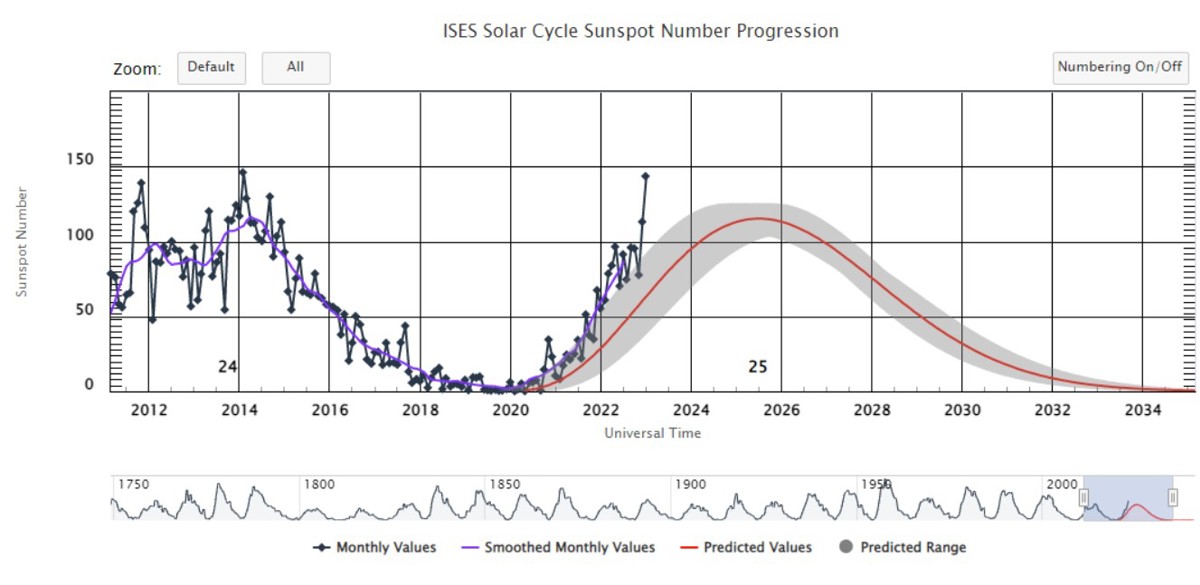Prepare for 2025 solar activity
- DP Event
- Published on 29 July 2024
- Generated on 22 December 2025
- DPE 02/24
- 4 minute read
Undesired event
Jump to:
This case study covers events that occurred on the same vessel, eight months apart.
1. Overview
The DP equipment class 2 vessel is fitted with six position references systems, three DGNSS, two HPR and one laser based. At the time of the DP Incident the vessel was employed in subsea operations with two ROVs and a deck crane and operating with only two DGNSS position references systems selected into the DP control.
2. What happened?
Late one evening the DPO noted instability of the DGNSS differential signal and shortly after DGNSS 1 and 2 both dropped out of DP control. When the systems were accepted back into DP control the vessel had made a 30m uncontrolled movement.
This was not however an isolated event and over the next four-month period whilst the vessel was engaged on that specific project the DPOs regularly experienced unstable DGNSS differential signals between the hours of 18:30hrs and 22:45hrs. On occasions the vessel was left in a dead reckoning mode for several minutes, therefore after consideration and a risk assessment being undertaken the vessel had to suspend all critical operations during these hours.
Both DGNSS receivers were of the same type and model. The OEM was contacted, and the support team clarified that the issues they were experiencing were caused by excessive ionospheric disturbances in the area – scintillation.
Initial recommendation to switch one DGNSS receiver to another correction service provided a short-lived response until ionospheric activities increased further and then both satellite correction services were both affected again.
The next step was for the vessel to upgrade the receivers to the most up to date model, which has been designed to track not only GPS and GLONASS, but also Galileo and BeiDou constellations, and is also capable of receiving signals on L2, L3 and L5 frequencies, thus the impact of ionospheric jamming could be reduced.
Four months after the receiver upgrades the vessel witnessed two simultaneous GNSS losses, due to satellite dropout. On this occasion the vessel-maintained position on the remaining position reference system GNSS 3, which was a different manufacturer. The vessel sought advice from the OEM and subsea operations were suspended until stable GNSS positions could be maintained.
3. Findings
Following the most recent DP incident, the OEM of GNSS 1 & 2 were contacted and solar interference was again confirmed as the problem for the dropouts and that many other vessels operating in the same area were also experiencing technical problems.
Having already upgraded the hardware of the two receivers the OEM support advised the update of firmware and Quantum software in both GNSS receivers. Following the updates, final checks and tuning were completed along with DP checklists and the vessel was able to resume the subsea operations.

4. Conclusions
Cases like the ones described above are becoming increasingly common as we move rapidly towards 2025.
The ionosphere is a region in Earth’s upper atmosphere, and it is where solar radiation causes ionization, creating a layer of electrons that can affect various Earth systems including our communications and navigation.
We are currently in the 25th solar cycle and are approaching its peak, which is expected to occur between 2025 and 2028, this is when the interference to our technologies will be at their highest.
It is therefore imperative for all vessel operators and ships crew to be aware of the risks involved in over reliance of the DGNSS position reference systems.
Follow the manufacturers’ advice on updates of hardware, firmware or software that are designed to aid through these increased solar activity periods.
-
Increasing solar activity and the effect on GNSS positioning
Global Navigation Satellite Systems (GNSS) have revolutionised the way we navigate but are prone to interference.
March 2023
Information Note
-
Enhanced GNSS differential corrections for Dynamic Positioning (DP) operations
GNSS serves as a critical Position Reference System (PRS) in Dynamic Positioning operations.
March 2024
Information Note
Latest DP incidents
-
Simultaneous Operations
A DP Incident report highlighting the importance of maintaining focus during time on the DP desk
DPE 03/25
18 December 2025
Incident
-
DP drill scenario
DP emergency drill scenarios are included to assist DP vessel management and DPOs / Engineers and ETOs to conduct DP drills onboard.
DPE 03/25
18 December 2025
Drill Scenario
-
Know your settings
This Dynamic Positioning (DP) incident involved a DP equipment class 2 offshore supply vessel (OSV) during loadout operations from a drilling rig.
DPE 03/25
18 December 2025
Incident
-
Importance of familiarisation and paying attention
The importance of maintaining full attention during the operator's time on the DP desk can never be underestimated, or forgotten
DPE 03/25
18 December 2025
Incident
-
Worst case failure preparedness
Operators must be prepared for worst case failures
DPE 03/25
18 December 2025
Incident
The case studies and observations above have been compiled from information received by IMCA. All vessel, client, and operational data has been removed from the narrative to ensure anonymity. Case studies are not intended as guidance on the safe conduct of operations, but rather to assist vessel managers, DP operators, and technical crew.
IMCA makes every effort to ensure both the accuracy and reliability of the information, but it is not liable for any guidance and/or recommendation and/or statement herein contained.
Any queries should be directed to DP team at IMCA. Share your DP incidents with IMCA online. Sign-up to receive DP event bulletins straight to your email.